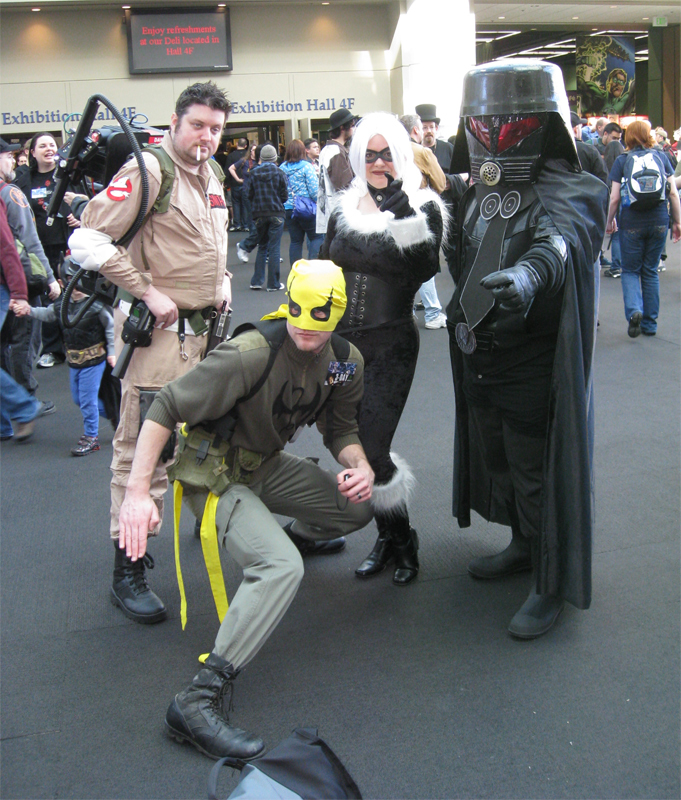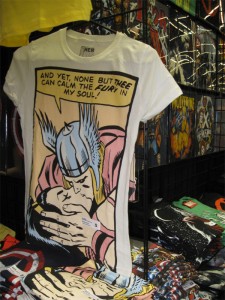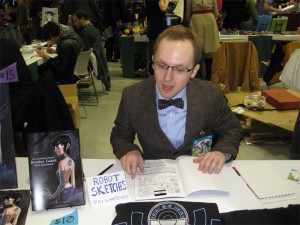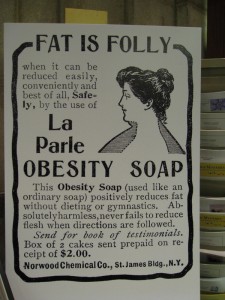 The softer side of April casts a pale pink spell over the campus of the University of Washington. We gladly succumb.
The softer side of April casts a pale pink spell over the campus of the University of Washington. We gladly succumb.
Lend Me Your Ears
Where does enchantment lie?
Some say the eyes. Some say the lips. Still others succumb to the seductive spell of great hair.
Ears rarely enter into it. Yet, in the vast canon of fictional heroes, one character alone ranks above all others in the ear category. Mr. Spock’s greenish skin, slanting eyebrows, and air of self-control helped set him apart from the rest of the crew of the original Star Trek when the show began in 1966. But it was Spock’s pointy ears that caught the public eye and won their hearts.
Next week, on April 2, one of those legendary ears will be auctioned off in Los Angeles. Bids are already rolling in, and experts predict the ear will go for at least one thousand dollars. Detached from Leonard Nimoy’s stately head, the silicone latex prosthetic attachment looks like a broken half of a fortune cookie, and hardly more valuable. But of course, the value of memorabilia is in the mind of the beholder.
Spock’s ear symbolizes the triumph of reason over emotion, wisdom over folly, sanity over the other thing. The sort of calm clear-headedness Spock’s character embodied remains an elusive goal for most of us ordinary humans. As a general rule, we can maintain calm, reasoned thought for only so long. Inevitably life’s slings and arrows poke us just once too often and off we go, flying into the irrational emotional tailspin represented on the original Star Trek in the all-too-human characters of Captain Jim Kirk (William Shatner’s defining role) and Dr. Leonard “Bones” McCoy.
Mr. Spock’s iconic ears resonate beyond the generation that grew up when Star Trek was new because succeeding generations still cling to the idea that brains can trump brawn, in spite of the continual evidence that it is by no means a sure thing. Perhaps that’s why we’ll pay a thousand bucks for a limp fake ear. Because, as James T. Kirk was fond of saying, we humans need to believe in the possibility of the impossible. We need belief. In ourselves, in our friends, in our nations, and in our dreams.
Another famous symbolic prop emerged in the golden era of Hollywood film when Dorothy donned the legendary ruby slippers in The Wizard of Oz. Of course, there were several pairs created by the props department, and over the years a few have been auctioned off. At the first auction by MGM in 1970, the red slippers went for $15,000. At the most recent sale in May 2000 they sold for $666,000. And they’re not even real rubies.
Of course, it’s not simply the shoes that people want. It’s the evocative power of their back-story, and the line that will forever be connected to them: “There’s no place like home.” That one goes deep into the well of human longing. E.T. longing. Thomas Wolfe longing. Eden.
On the face of it, Spock’s greenish pointy ears might not seem as embedded with significance, unless you step back, way back, lunar probe distance, and take a long look. From that perspective you can see, “There’s no place like space.” The final frontier. And it could be, if we don’t stop poisoning this planet.
The current unfolding nightmare in Japan should be enough to alert any rational human to the dangers of creating massive amounts of toxic waste for which we have no clean-up solutions. Yet the starry-eyed nuclear energy advocates insist we’ll figure out a way to deal with it eventually. It’s been more than sixty years since we started spreading radioactive waste around, and there is still no “solution” in sight.
Rational voices fall on deaf ears of corporate and political powers focused only on short-term profits at the expense of long-term planetary suicide. Perhaps the nuclear advocates sincerely believe that Science will somehow find a way to rewrite the laws of physics and biology, or, failing that, when we completely contaminate this planet, we can start over on another fresh planet.
Our continuing investment in nuclear energy is like a balloon mortgage on our planet. When it comes due, there’ll be hell to pay.
Where is Spock when we need him? Obama’s got prominent ears. If only they were a little more pointed.
Spring Tease
 You can’t miss her if you’re driving along I-5 Northbound.
You can’t miss her if you’re driving along I-5 Northbound.
For whatever reason, some fan of the female form elected to give weary motorists a lift by painting an eye-catching homage to the amazing Bettie Page on the side of his house. I, for one, am grateful.
The now-you-see-it, now-you-don’t quality of springtime in Seattle demands that we all pay close attention to the breaks in the clouds. In a couple more months those blue skies will linger longer. But until then, we’ll keep our extra layers and our umbrellas handy, and try to keep our eyes on the road.
What Lies Beneath

Images of whales abound in the Northwest. Tourists come from miles around in hopes of seeing orcas breach the surface of Puget Sound. Cute cartoons of black and white whales adorn everything from coasters to key chains.
Surrounded by the casual commoditization of the idea of killer whales, it’s easy to forget the power and awesome reality of the actual creatures.
But on a windswept expanse of open ground at Magnussen Park in north Seattle a remarkable work of public art conveys the mystery and the grandeur of whales in an unexpected way.
Seattle artist John T. Young created “The Fin Project: From Swords to Plowshares” in 1998 using 22 decommissioned diving plane fins from 1960s U.S. Navy attack submarines. Massive steel fins rise out of the ground, some atilt, some buried deeper. The effect is subtle yet striking. As you walk among them you can’t help imagining giant creatures below the surface.
It’s what you can’t see that sparks the imagination.
The work resonates in many ways, but yesterday, as I revisited the site, I found myself thinking of the way we all carry on blithely on the surface of this Earth, taking for granted its solidity, its gravity, the secure foundation of our homes and hopes, forgetting, as we humans are so apt to do, that the Earth has issues of its own. The horrific devastation in Japan from the most powerful earthquake in its recorded history reminds us how puny we are in the big picture. The Earth shrugs, our fragile civilization collapses.
In the years to come, as we rebuild from this most recent natural disaster, more such events are inevitable. The continued survival of mankind will depend on our ability to help one another. Beating swords into plowshares is a start.
King Con

I spent most of yesterday being someone I’m not. Sort of a vacation from myself. I wasn’t alone.
At the Seattle Convention Center, the Emerald City Comicon was swarming with thousands of devotees of fantasy, sci-fi and general all-purpose make-believe. My kind of people.

I had always wanted to attend one of these things, but, lacking willing companions, held back, not wanting to be the lone pathetic geezer in the mosh pit, so to speak. But when one of my daughters urged me to go with her group, I ended up playing a role with which I am all too familiar: the “ironic housewife” from a sort of interactive online comic called “Homestuck.”
I know almost nothing about computer games. I’m in awe of their complexity, the speed with which the younger generation masters them, and the level of artistry in their world building and character design. However, “Homestuck” isn’t quite like any of the usual shoot ’em up, find the talisman type games. It’s kind of an existential ironic riff on the limitations of human experience and computer programming. With monsters.

I played along because, really, my main motivation for attending this particular con was that Spike was going to be there. If you don’t know who Spike is, what can I say? There’s too much back-story to cover, but, in short, he was a character on the iconic television series Buffy the Vampire Slayer and, for my money, he was the most charismatic vampire ever. Bar none. Over the course of six seasons his character continually evolved. He went from your basic blood-sucking demon, to a kind of neutered comic relief bad guy, who gradually developed a crush on his worst enemy, and ultimately, through intense personal suffering, became a heroic figure who literally saved the world. Not bad for a bleached blond creature of the night.
So, when I learned that James Marsters, the actor who played Spike, would be at this year’s con I knew I wanted to go, even though I had reservations. It can be a rude awakening to encounter one’s heroes in the harsh light of reality. Sometimes they seem a lot shorter, shallower, less heroic.
As I waited in the dark auditorium with six or seven hundred fellow enthusiasts, I hoped James wouldn’t let me down. He didn’t. As part of a three-member panel of former Buffy actors, he shone with self-effacing wit, humor and intelligence. I didn’t even mind that he spoke in his normal voice, rather than the pseudo-Cockney accent which was part of Spike’s enduring charm. I left the auditorium feeling soothed and uplifted. Not only because James didn’t disappoint, but because the entire event reminded me of why I love my counter-culture.

There were representatives from all corners of the universe at this thing. They came in all ages, all sizes, all genders, and embracing a vastly diverse spectrum of belief systems. And the mood among the thousands of fans was one of mutual admiration, tolerance and respect. Sort of like the way we used to think democracy would turn out.
I realize that sci-fi fans and fantasy geeks are still in the minority in this country. But I think what they bring to the table has value far beyond the box-office. The idea that humans have room for improvement, the hope that other worlds might know a few things we could stand to learn, the hope that we can all someday just learn to get along with each other. Yeah. Maybe that’s too far-fetched. What can I say? I’ll believe anything.
Ou Est la Biblioteque?

There’s a lot of talk going around these days about how the Book is dead. Or at least on its way out, drummed into the dust by the chattering hordes of hi-tech gadgets that make the act of turning paper pages seem quaint, not to mention ecologically incorrect.
But for those of us who still thrill to the whisper of the turning page, there remain a few bastions of the printed word where books get some respect. The Library of Congress covers three blocks right behind the Capitol, where politicians and news makers fill the air with their boasts and claims of knowledge and virtue. But inside the Library, the atmosphere has the hushed gravity of a cathedral, and the workers scuttle through the miles of stacks with the quiet reverence of acolytes to a higher god.
You can almost feel Wisdom floating in the air.

For a bookworm like me, it’s an exciting place. I have been visiting libraries all my life, never happier than when wandering the stacks, inhaling that slightly musty scent of old books.
In Seattle the library system is terrific, with well-designed branches all over town which use the newest technologies to share their collections. And the city’s flagship Central library is a stunning work of modern architecture by Rem Koolhaas, its soaring glass walls reflecting the city lights like a beacon of progress.Inside, bright colors and modern art distinguish the many floors linked by a clever system of escalators and ramps that carry patrons up through the building. It’s a marvel, and, though still a source of some controversy, it draws thousands of tourists each year who come to see the building even if they don’t read much.
By the same token, tourists to the nation’s capitol visit the Library of Congress because in its vast collections it holds some of the most famous and revered documents of our country, as well as some unexpected treasures. The Guttenberg Bible is there, for instance. And there’s also an amazing collection of rare musical instruments, recordings and newspapers.
Naturally, the architecture reflects the classical tradition, with magnificent ceilings embellished with allegorical art and breathtaking stonework.You could get a crick in your neck trying to read the ceilings alone. It’s all fairly wonderful.
But not everyone who visits the LoC cares about the building or the books. When I was there this week enjoying a kind of behind the scenes tour with a friend who works there, we came upon a group of young visitors, maybe high school age, who bustled into the lofty entry area of the main building. They gazed around restlessly, clearly not overly impressed by the gilding, the mosaics or the quotations on the walls. After a few seconds one of them, noticing my friend’s badge, asked if she could tell them where the “secret room” was. She shook her head and replied, “Did you lose your guide?”
The guy nodded and said, “But you work here. Can’t you tell us where it is?”
“Do you mean the Dan Brown book?” she asked.
The guy nodded again. My friend told them to wait for their guide, who would be able to answer their questions.
She told me as we moved on that interest in The DaVinci Code has led to an influx of visitors whose passion for books is perhaps not as keen as their passion for hot topics.
Still. They came to the library. That’s a start.
The power of words, to lead or mislead, to inspire love or hate, to clarify or obfuscate, remains. Some people choose to live their lives according to the words of one book or another. Yet, much as I love words and books, I’m not sure that relying on one book is the best idea, no matter how old or how respected that book may be. It’s a big universe. Ours is a small planet. One book may be enough to change the world, but if we hope to save it, I think we’d do well to read more.
A lot more.
Rant Cant

I chanced to see Network again last night and was riveted by the impression that what passed for satire 35 years ago has become business as usual today.
In 1976, when the film won four Oscars and was nominated for another handful, Paddy Chayefsky’s sharp skewering of the corporate struggle for media domination offered a fresh take on what was going on behind the curtain in Oz.
But now, with “reality” programming smearing the line between truth and fiction, aided and abetted by the constant streaming of opinion and rumor on “social” media such as Twitter and Facebook, the distinction between satire and real reality has become harder to detect.
Watching Peter Finch as the outraged news broadcaster on a struggling television network deliver the classic rant, “I’m mad as hell and I’m not going to take it anymore,” I couldn’t help wondering if that rabble rousing cry didn’t somehow lodge in the subconscious of an entire generation of budding talk show hosts. We’ve all heard their names. I prefer not to add one more twig to the bonfire of their vanities. But as the daily news continually illustrates, rabble rousing is a risky business. Mobs aren’t known for clear thinking. And regimes confronted by mobs can’t be expected to behave rationally either.
So far, it looks like we got lucky in Egypt. The people who got mad as hell were allowed to vent and the response was measured, not as violent as it could have been, and the hope for peaceful progress remains alive. However, it remains to be seen whether the domino effect in the region will lead to greater peace and freedom or worsening oppression.
Network ends on a cynical note of violence that was too shocking to be taken seriously in its time. But these days, when everyday violence seems as inevitable as the dandelions in the lawn, it’s harder to believe that peaceful solutions can succeed. Perhaps that’s why the jubilation in Egypt, however short-lived it may be, offers a breath of hope in a dark world.
Here in Seattle there are plenty of people who enjoy a good rant. The topics run the spectrum, from the economy to civil liberties or lack of same, to the vast conspiracy theories burning endlessly, pilot lights on the fires of contention.
But peaceniks still carry on, lighting candles, saying prayers, offering flowers. You might say that we’re dreamers. But we’re not the only ones.
Couch Gag
 Why does a couch cross the road?
Why does a couch cross the road?
The answer to this age-old riddle depends on whom you ask.
If you asked the infinitely creative writers of The Simpsons, they might suggest that the couch has deep personal issues of its own to work through. No doubt putting up with Bart and Homer all these years has left its mark on that particular couch.
But perhaps all couches need a break from being sat upon. If you asked writer Benjamin Parzybok, author of the whimsical and strange novel Couch, you might find yourself immersed in a couch odyssey, seeking nothing less than the meaning of life.
I came upon Parzybok’s book in a used book store a while back and was immediately drawn to its tagline: “Three guys move a couch, save the world.”
Wow. Talk about a story I can relate to. Who among us hasn’t moved a couch? Who among us hasn’t broken down in hysterical laughter while trying to maneuver said couch up a tight stairway? For me, for some inexplicable reason, moving furniture, particularly large unwieldy items such as couches or mattresses, up stairs, around narrow corners, into seemingly impossible positions, has always triggered fits of laughter. I think it has something to do with that feeling you get when you know you’re edging right up against the fractured borderland where the not funny becomes funny. Those moments when the realization hits you that you’re this close to dropping the piano, or the couch, or whatever. And then you have a choice. Either panic, or laugh. But whatever you do, don’t let go.
In Parzybok’s rambling misadventure story, the moving of a couch becomes an extended metaphor for all those perilous moments when things seem too heavy to deal with, yet deal we must.
I wouldn’t recommend the book for everyone. It’s kind of a Portland thing. It’s weird. But, if you like that sort of thing, it’s kind of great.
Seattle has its own love affair with the weird and quirky, and in a quiet corner of Ballard a pocket park pays tribute to the humble couch. At first glance the concrete couch at Ballard Corners Park looks so inviting and homey, you might plop down on it before checking to see if its soaking wet. Rain won’t damage this couch, but soggy pants are a downer.
But should you come across this couch corner on a sunny day, it offers a wonderful change from the usual park bench. It invites you to sit a while and ponder the mysteries of life. And couches.
Bob
Some don’t like his voice. Some can’t stand his music. Some never forgave him for going electric back in the ’60s.
But for me, Bob is the One.
I like his voice. I love his music. There’s nothing to forgive.
He’s given me more solace, more pleasure, more soul satisfaction than any of the multitude of blandly pleasant popular crooners whose forgettable tunes rise and fall on the charts with as little lasting impact as the bubbles in a glass of champagne.
The best of Bob’s music is the stuff of poetry, with its wild free-wheeling imagery and close to the bone insight. Even his few mediocre recordings in the course of a career enduring more than forty years have a lyrical integrity that eludes most others. But little of his vast output is radio-friendly. I suspect that to kids today Bob is known almost exclusively as the creator of “Mr Tambourine Man” and “Blowin’ in the Wind,” and to a slightly lesser extent, for “Like A Rolling Stone.” And of course, in the case of the first two, the covers by The Byrds and Peter, Paul, and Mary, respectively, have enjoyed more airtime than Bob’s original recordings.
But those of us who light candles in the Church of Bob tend to favor works less widely known. “Sad-Eyed Lady of the Lowlands” still casts a spell that takes me back to a time when many of my generation thought music could change the world. I no longer believe that any one song has that power. But “Visions of Johanna” takes my breath away. And “Dear Landlord” still hits the mark. The anti-war anthem “With God on Our Side” is as powerful and relevant today as it was in 1964.
So, yeah. When I hear people talk about what kind of music they like these days, and they rave about whoever it is, be it Taylor Swift or Kanye West or any of the thousands of bright young bands mixing and mashing up musical styles for the great buffet of modern musical tastes, I nod and hold my tongue. Unto each generation is born a new roster of talent. Some got it. Some don’t. As Bob himself once sang, “Time will tell who has fell, and who’s been left been behind.”
My guess is, it won’t be Bob.
Goths to the Flame
Seasons come and seasons go, but complaints about the weather never wane.
As we reach the end of a dreary January here on the Northwest coast, we dare to hope that conditions will improve. Perhaps the sun will come out once or twice a week for an hour or two. Is that asking too much? Or, failing that, at least there may be an end to the moaning and griping from friends and relatives back East who’ve had more than enough snow this winter.
The thing about weather is: it can always be worse. Some of us take comfort from this. After all, when you live somewhere cold and dark for nine months of the year, you can take a kind of grim satisfaction in the fact that at least you don’t have to dig your car out from under two feet of snow every weekend. Nor do you have to contend with heatstroke and failing air conditioners. No indeed, here in the Shire all we need are three or four thick sweaters, a layer of Gore-Tex, an industrial strength espresso machine and an impenetrable shield of denial and we can get through winter’s gloom. And spring’s, and fall’s for that matter.
But there’s no denying that at this stage in the calendar year we are not immune to the siren song of sunlight, however fleeting and cold it may be.
Thus, last weekend, when the clouds thinned just long enough to allow some glittering rays to reach the Sound, some of us threw on our parkas and scampered down to the shore to enjoy the moment, before it vanished, and we trudged back to our dark bungalows to dream of brighter days ahead.
